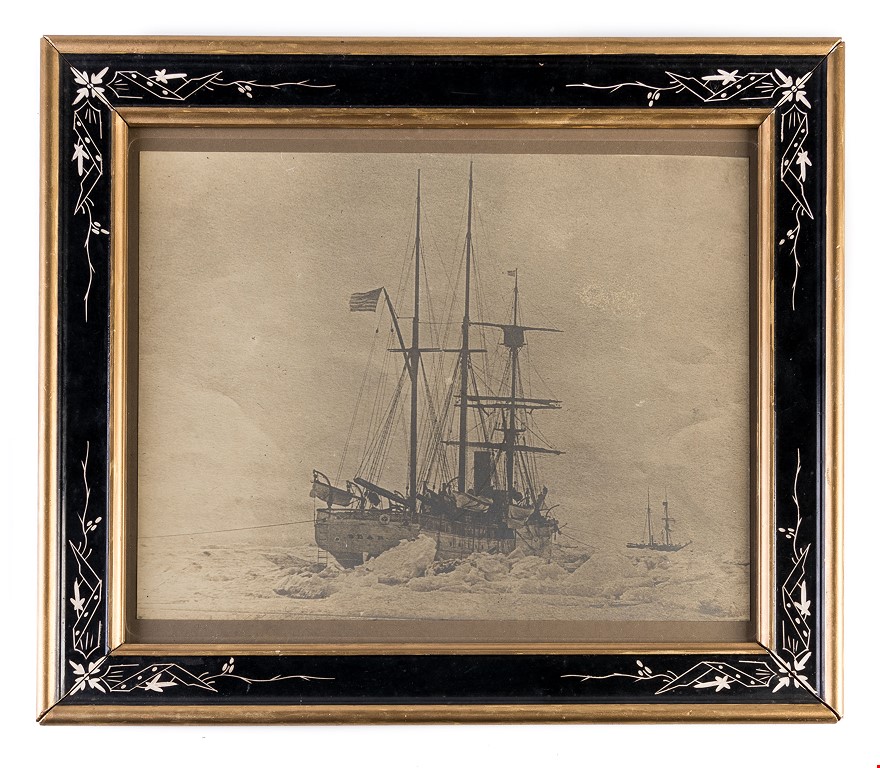Photograph of USRCs Bear and Thomas Corwin in the Arctic ice.
USRC BEAR ([c.1887].)
£750.00
Available to view at our Curzon Street shop.
A POLAR SHIP WITH AN AMAZING STORY
Albumen print on paper, laid down on board, framed and glazed in black and silver frame engraved with folk-art embellishments. Size of print: 285 by 220mm Size of frame: 370 by 315mm. Print slightly faded with sepia hue. N.p. [Arctic Ocean], N.d.
An attractively framed photographic print of probably America's best loved polar vessel, The Bear. Here pictured in the Arctic ice, with her companion ship The Thomas Corwin visible in the background.
A Scotland-built dual steam-powered barquentine, The Bear had an exceptionally long and varied career, spanning 89 years (1874-1963), serving in both polar regions, and under the flags of three nations - USA, UK and Canada.
Originally purposed as a sealing vessel, her 6 inch thick hulls made her an invaluably strong contender in the crush of pack ice, and she was purchased by the US government in 1884 to assist with the search for the lost Lady Franklin Bay Expedition, headed by Captain Adolphus Washington Greely. Failures of relief ships meant that this disastrous expedition had attempted to make their own way south from Ellesmere Island, and by the time they were discovered by Captain Schley's rescue fleet of the USS Thetis, Alert & Bear, all but six members were dead. They had endured awful hardships including frostbite, starvation and cannibalism. Greely executed one member of the crew for repeatedly stealing food.
At the point of The Bear's career at which this photograph was taken, she was serving the United States Revenue Cutter Service (predecessor of the US Coastguard) under the captaincy of the monumentally charismatic Michael "Hell Roaring Mike" Healy. Captain Healy was born into slavery in Georgia in 1839, the son of an Irish immigrant planter and a mixed-race enslaved mother of African descent. His common-law married parents sent him north for education, and he went on to become the first African American to command a US government ship. In USRC Bear, he patrolled the Alaska coastline, policed the illegal traffic of whiskey, saved the lives of many shipwrecked and icebound whalers, arrested seal poachers, and notably introduced reindeer from Siberia to Alaska to relieve the indigenous community's food crisis caused by the over-hunting of the whale and seal populations. He was a notorious drunk, but greatly respected by the indigenous communities he encountered in the Pacific Northwest and Arctic regions. This photograph can be identified to this period of the ship's career by the presence of her companion vessel USRC Thomas Corwin, the two masted steam powered top sail schooner in the background of the picture.
After Hell Roaring Mike, The Bear provided relief to the 1906 San Francisco earthquake (coincidentally an effort headed by Major General Greely) and was subsequently purchased by Commodore Richard Byrd, who took her to the Antarctic on his second expedition, and then leased her back to the US navy for $1 per year. She starred in the title role in Jack London's 1930 film The Sea-Wolf, evacuated US citizens from Antarctica at the outbreak of WWII, then retired to Oakland as a museum. She ultimately sank with dignity in the North Atlantic in 1963, on her way to Philadelphia to become a floating sea-food restaurant.
Stock Code: 227936




